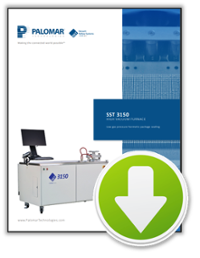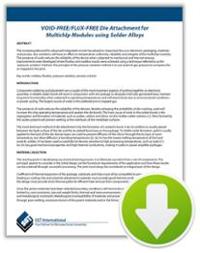Liquid flux (acidic base or inorganic based) has traditionally been the primary solution to allow soldering of metal parts with surface oxides for high quality wetting of the solder to these metals. However, there are significant flaws or issues with the use of flux in soldering.
Issue #1: Flux Residue. Flux residue is known to react with water vapor to create an acidic solution surface that will react with and corrode metal connections. This results in possible metal shorts and opens and reduces reliability and long term life of the electrical connection.
Issue #2: Voiding. Flux, whether in liquid form or as a constituent of solder paste, has liquid components that vaporize or outgas during the soldering reflow high temperature, resulting in trapped voids or bubbles in the solder joint. These gas voids can displace heat and electrical paths which can cause non-uniform patchy heat transfer and can concentrate heat in localized areas, resulting in stress and possible cracks.
The ideal solution would be to achieve a flux-free soldering reflow environment by reducing or removing the surface oxides from the metals to be jointed without the use of flux. Historically, forming gas (hydrogen/nitrogen mixture ranging from typically 5% to 10% hydrogen/balance nitrogen) has been used to reduce surface oxides. In the worst case, up to 100% hydrogen (this is dangerous and requires explosion compatible equipment) has been used to remove oxides. Unfortunately, forming gas is most effective at temperatures of 350°C or higher, which is not compatible with lower melting temperature solder alloys.
An alternative compatible at a lower temperature range is the use of formic acid vapor to reduce surface oxides. The formic acid vapor chemically reacts with the metal oxides to create a salt or formate at a low temperature. Subsequently, raising the temperature decomposes the formate salt to carbon dioxide, water, and hydrogen. This is a two-temperature step operation which is shown below.
SST Vacuum Reflow Systems has incorporated a formic acid delivery system into the soldering chamber via a nitrogen carrier gas with flow rate control of the acid concentration into two vacuum/pressure solder reflow models (Model 1200 Table Top Furnace and Model 5100 Vacuum Pressure Furnace). The images below show an example of copper oxide removal.


|
How Does Formic Acid Work?
|
|
Target Acid Concentrations Below are target acid concentrations for soldering applications:
|
References:
“Fluxless Solder Reflow Using Formic Acid Vapor”, Tyan T. Martin et al, Proc. IMAPS New England 30th Annual Symposium and Exhibition, Boxboro, MA pg 167-171 2003
“SNL Initiatives in Electronic Fluxless Soldering” F.Michael Hosking et al, Sandia National Labs 1991
“Reduction of Solvent Use Through Fluxless Soldering” F. Michael Hosking Sandia National Labs 1990
Download these resources for more information:
Model 1200 Data Sheet |
Model 3150 Data Sheet  |
Void-Free Die Soldering Paper |
----
Pierino Zapella
Process Development Engineer
SST Vacuum Reflow Systems